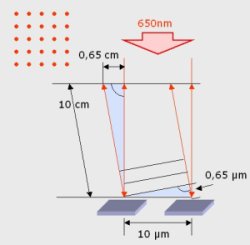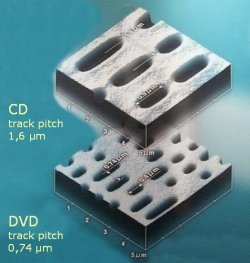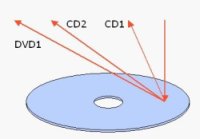
Usual Laser pointers have a wavelength of about 650nm. For safety reasons their radiation output is or should be limited to 1mW. Some with better visibility for the same power are made with diodes emitting at 635nm and some are even available with green light.
To determine the wavelength one can compare the colour of the light with a picture of the spectrum with a scale fig 1.
 |
Diffraction Measurement with Memory Chip
It will of course be more precise to measure the wavelength with an optical grid. Such a grid is not necessarily a grid made for optical measurement. One fist example of a grid is a chip with a structure that is in the range of the wavelength.
The structure of chips is copied to the wafer with optical masks. Over the last decades the structure has become more and more fine until it has reached the limits of the optics and wavelength had to be shifted to ultraviolet. Chips and in particular memory chips with their regular structure will show a diffraction pattern when light is reflected from their surface.
When taking an ancient 1Mbit chip with an area of 100 mm² the pattern can be estimated with an even distribution of the memory cells as 10 000 cells per mm² . With 100x100 cells on every square mm the pitch will be 10 µm.
When the laser illuminates the chip like in fig 2, the cell pattern reflects the light into all directions. All angles under which the light of neighbouring cells in in phase will be preferred. This is the direct reflection and the direction in which the phase difference is one wavelength. Further all directions in which the phase difference is a whole number of wavelengths.
 |
Regarding the blue triangles one with the base of 10µm, between the cells and the other with a basis of 10cm, more or less the distance to a screen, one can say, that the next point on the screen will be 0,65cm aside from the direct reflection.
With all other points where the difference between neighbouring reflections is a whole number of wavelengths, a regular pattern appears.
Diffraction measurement with CD and DVD
An other type of grid with high precision is very common, it is the CD ROM. The grid is standardised so that its pitch is just known as 1.6 µm for the CD and 0.74 µm for the DVD.
With a perpendicular laser beam being reflected from the surface, the angle of diffraction is much larger than with the ancient memory chip. For a wavelength of 650 nm it is 24° and 54° for the CD and 61° for the DVD fig 4.
 |
 |